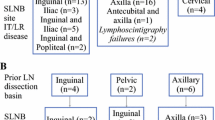Abstract
Background: We report the experience of the World Health Organization (WHO) Melanoma Program concerning sentinel lymph node (SLN) biopsy for detecting patients with occult regional nodal metastases to submit to selective regional node dissection.
Methods: From February 1994 to August 1998, in 12 centers of the WHO Melanoma Program, 892 SLN biopsies were performed in 829 patients with clinical stage I melanoma (male: 370; female: 459; median age: 50 years old). The location of the primary melanoma was as follows: trunk, 35%; lower limbs, 45%; upper limbs, 18%; and head and neck, 2%. Blue dye injection for SLN identification was performed in all cases; preoperative lymphoscintigraphy was one in 440 patients, and an intra-operative probe for a radio-guided biopsy was used in 141 cases. Overall, the SLN identification rate was 88%. In 68% of the patients, only one SLN was identified, whereas two and three or more SLN were detected in 24% and 8% of the remaining cases, respectively.
Results: Overall SLN positivity rate was 18%. Intra-operative frozen section examination was performed in 39% of the cases and was helpful in detecting occult localizations only in 47% of the positive SLNs. Distribution of positive cases by primary thickness was as follows:,1mm: 2%; 1–1.99 mm: 7%; 2–2.99 mm: 13%; and 3 mm: 31%. Positive nonsentinel lymph nodes were found in 22% of cases with positive SLN submitted for selective dissection. No complications due to the procedure were registered. Of 710 patients who were evaluated, 40 (6%) presented a regional nodal relapse after a negative SLN biopsy and underwent a delayed therapeutic dissection. From the 710 enrolled cases, 638 (88.5%) were alive without evidence of disease at the time of this writing. A multivariate analysis showed SLN status as one of the most significant prognostic factors (P 5 .000) along with thickness (P 5 .001) and ulceration (P 5 .015) of primary tumor.
Conclusions: These data confirm the feasibility and safety of the SLN technique for selecting patients to submit to a radical node dissection. The data represent the basis for a future trial by the WHO Melanoma Program in this field to evaluate the most appropriate surgical approach for treating patients with occult regional nodal metastases.
Similar content being viewed by others
References
Morton D, Wen DR, Wong JH, et al. Technical details of intraoperative lymphatic mapping for early stage melanoma. Arch Surg 1992;127:392–399.
Morton DL, Wen DR, Cochran A. Intraoperative lymphatic mapping for early-stage melanoma. The Melanoma Letter 1992;10: 14.
Cochran AJ, Wen DR, Morton D. Management of the regional lymph nodes in patients with cutaneous malignant melanoma. World J Surg 1992;16:214 –21.
Krag DN, Sybren JM, Weaver DL, et al. Minimal access surgery for staging of malignant melanoma. Arch Surg 1995;130: 654–8.
Alex JC, Krag DN. Gamma-probe guided localization of lymph nodes. Surg Oncol 1993;2:137– 43.
Reintgen D, Wayne Cruse C, Wells K, et al. The orderly progression of melanoma nodal metastases. Ann Surg 1994;220:759– 67.
Reintgen D. Lymphatic mapping and sentinel node harvest for malignant melanoma. J Surg Oncol 1997;66:277– 81.
Cascinelli N, Belli F, Leo E, Vaglini M. Nodal dissection for cutaneous melanoma (videotape), WHO Melanoma Programme. European School of Oncology 1988.
Kapteijn BAE, Nieweg IE, Liem IH, et al. Localizing the sentinel node in cutaneous melanoma: gamma probe detection versus blue dye. Ann Surg Oncol 1997;4:156–60.
Belli F, Lenisa L, Clemente C, Tragni G, Mascheroni L, Gallino G, Cascinelli N. Sentinel node biopsy and selective dissection for melanoma nodal metastases. Tumori 1998;84:24–8.
Ross MI. Surgical management of stage I and II melanoma patients: approach to the regional lymph node basin. Semin Surg Oncol 1996;12:394–401.
Cochran AJ, Wen DR, Morton DL. Occult tumor cells in the lymph nodes of patients with pathological stage I malignant melanoma. Am J Surg Pathol 1988;12:612–18.
Cascinelli N, Morabito A, Santinami M, MacKie RM, Belli F, on behalf of the WHO Melanoma Programme. Immediate or delayed dissection of regional nodes in patients with melanoma of the trunk: a randomized trial. The Lancet 1998;351:793–96.
Gershenwald JE, Thompson W, Mansfield PF, et al. Multi-institutional melanoma lymphatic mapping experience: the prognostic value of sentinel lymph node status in 612 stage I or II melanoma patients. J Clin Oncol 1999;17:976–83.
Thompson JF, McCarthy WH, Bosch CMJ, et al. Sentinel lymph node status as an indicator of the presence of metastatic melanoma in regional lymph nodes. Melanoma Res 1995;5:255– 60.
Glass LF, Fenske NA, Messina JL, et al. The role of selective lymphadenectomy in the management of patients with malignant melanoma. Dermatol Surg 1995;21:979–83.
Glass LF, Meddina J, Glass J, et al. The results of complete lymph node dissection in 88 melanoma patients with positive sentinel nodes. Melanoma Res 1997;7(Suppl 1)104.
Author information
Authors and Affiliations
Corresponding author
Rights and permissions
About this article
Cite this article
Cascinelli, N., Belli, F., Santinami, M. et al. Sentinel Lymph Node Biopsy in Cutaneous Melanoma: The WHO Melanoma Program Experience. Ann Surg Oncol 7, 469–474 (2000). https://doi.org/10.1007/s10434-000-0469-z
Received:
Accepted:
Issue Date:
DOI: https://doi.org/10.1007/s10434-000-0469-z




